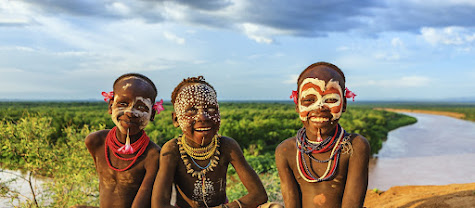FROM IN-DIGENOUS TO OUT-DIGENOUS
Previously, I scrutinised the impacts of the Gibe III dam on the hydrology and ecology of Lake Turkana. This blog will focus on socioeconomic situations which domino into effecting on food production, and the role of food as a weapon in the Omo-Turkana region.
Official assessment of the environmental and social impacts (ESIAs) of Gibe III downplayed the the implications of the dam for downstream populations, and only began following the start of construction works in 2006 (Monteil and Kinahamn, 2015). These published ESIAs ignored the socioeconomic consequences of plantation development on the 200,000 indigenous people which reside in the basin.
Traditional Livelihoods
The indigenous inhabitants of Lower Omo rely on floods to naturally fill depressions near the Omo delta valley, inundating oxbows, stimulating resultant groundwater recharge and thus stimulating cultivation in the rangelands. Further, there has been accelerated deforestation and clearing of bushland and forests used by indigenous peoples (Baldwin, 2014).
Temporary Promises
The Gibe III promised to maintain a minimum of 25 m3/s in the river year-round, equating to under 6% of the river’s average daily flow. This will be done through temporary flood release, which would allow for flood recession agriculture only until the indigenous population were socio-economically forced away from their traditional practices. Despite the dam having the hydraulic capacity to release a controlled flood of 1,000–1,200 m3/s for 10 days in September, which would satisfy environmental and human needs. The project protagonists have labelled the traditional livelihood practices of the indigenous communities as “primitive” and “backward” , echoing colonial imperialist and colonialist beliefs (Avery & Tebbs, 2018:24). In rhetoric to my blog on colonial pasts, this situation demonstrates how white saviour syndrome resumes to reinforce these false attitudes, inferring that people of colour need strong white leaders to rescue them and make informed decisions on behalf; Overall disregarding the century old knowledge the locals have of their land, and possibly closing off effective food management systems.
Food as a Weapon
Human rights organisations and environmental groups have voiced their concerns surrounding these agricultural projects…But a 2010 palm-oil plantation in the Omo Valley offers a cautionary tale. Members of the Suri tribe were forcibly removed from their land, and following retaliation from the tribe, government forces killed 54 unarmed Suri in a public marketplace (Fong, 2015). Following this, the Suri were forced to hunger, thus accepting defeat and relocating- demonstrating how food can be used as a weapon in water stressed regions.
'Imprisoned Waters - The Gibe III dam, plantations, and the people of the Omo Valley, Ethiopia' (2019, October 23)
Around 150,000 indigenous people living near the sugar plantations have been relocated (voluntarily or forcefully) into permanent settlements. Government forces have demolished food stores, destroyed sorghum, thrown food in the river, and confiscated cattle, all in hopes of forcing people to settle in government villages. The addition of a massive earthen dam and extensive irrigation canals have been constructed to upkeep the Omo agricultural schemes…and to flood indigenous cultivation sites and the hundreds of dwellings of Bodi and Kwegu people upstream, sequentially crops downstream dependent on river flow (Hurd, 2013; HRW, 2014).
To Conclude…
Even if the Omo Turkana residents manage to adapt to the detrimental hydrological and ecology impacts of Gibe III, the socioeconomic abuse they receive from governing bodies will continue to challenges to traditional livelihoods and thus regional food security. Controlled floods, irrigating fodder crops, food aid, and benefit sharing should all be considered by the Ethiopian government as ways to maximise the advantages of the current developments while minimising their negative consequences.




Such a great post filled with amazing use of statistics. Its assess the variety of different outcomes that dams and other water management strategies can lead to. Do you believe outcomes like this are common in Africa or this is one of a kind example?
ReplyDelete